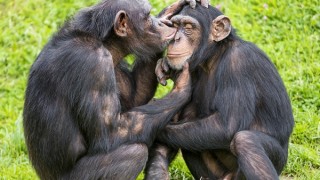
After studying a colony of chimpanzees in southern Guinea, researchers have established that wild chimps have a predilection for alcoholic sap. It’s thought the research could provide some insight into why humans are so fond of drinking alcohol.
At the crown of the trees, the local villagers tap the palms for their milk-like sap. The sap accumulates in plastic containers, eventually, fermenting into palm wine. While the villagers collect the containers every morning and evening, the chimps are provided with a window of opportunity in which to imbibe in a little palm wine.
As part of the 17-year-long study, the chimps were spotted using leaves to scoop up the sap. They would gather bunches of leaves, and chew them up into “sponge leaves.” These so-called sponges were then dipped into the containers, allowing groups of chimpanzees to suck out the alcoholic sap.
The research team worked out that that alcohol content of the sap was approximately three percent by volume. After drinking a fairly significant amount, researchers say many of the chimps were displaying obvious signs of inebriation. According to Dr. Kimberley Hockings of Oxford Brookes University, some of the chimps were indulging in up to 85ml of alcohol.
“[They displayed behavioural signs of inebriation, including falling asleep shortly after drinking,” stated Hockings.
Some chimps would climb to the top of the palms and drink in isolation, while other chimps would gather around the trees and “co-drink,” on a more social basis.
The research appears to support the “drunken monkey” contention, a theory that suggests the ability of humans and chimps to metabolize alcohol was passed down, genetically, from a common ancestor. This genetic trait would have allowed our ancestors to consume essential nutrients and vitamins from fermented fruits.
The study, entitled Tools to tipple: ethanol ingestion by wild chimpanzees using leaf-sponges, was published in the June 9 issue of the journal Royal Society Open Science.
